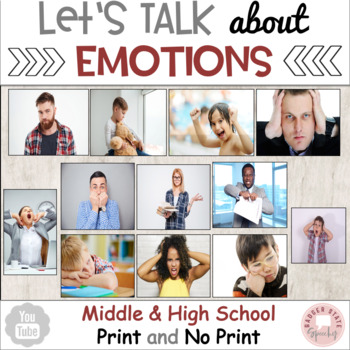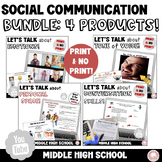Identify Feelings Emotions Social Emotional Middle High School
- PDF
- Easel Activity
What educators are saying
Also included in
- A social skills, social emotional and social communication bundle for your middle and high school students that focuses on social language and pragmatics while saving you money! All products in the bundle contain social narratives, youtube clips with fun activities, AND are digitalized on EASEL. TPrice $46.80Original Price $52.00Save $5.20
Description
►Looking for a print or no print packet to teach identifying feelings and emotions, using youtube clips and engaging activities to middle and high school students? This product uses real photographs, has relevant content for your students and is common core-aligned! Check out this in-depth unit (116 pages) for middle and high school tweens/teens with autism, Aspergers, ADHD and/or social communication delays. They need an in-depth program to teach them to improve their emotional intelligence and develop a robust emotional vocabulary. This multi-step activity packet works on the social communication goals of identifying emotions, matching emotion vocabulary words to pictures, identifying words and text messages that correspond to various emotions, understanding how the emotions we display impacts how we are perceived by others, matching emotions to scenarios and understanding that how we approach another person depends upon how they are feeling.
⭐This packet has been updated to be print or no print! It can be customized on TPTs digital platform, EASEL (I have added text boxes and digital directions) or you can use it as a printable. There are 101 slides that have been digitalized. Check out the EASEL version video preview.
☀ELA activities: synonyms, antonyms, using reference materials to determine meaning, choosing the best synonym and more!
There are activities to help your students "dissect" how a person's face and body look for 15 emotions.
✪✩✪ Real, color photographs (full size-one per page) appropriate for middle and high school students that depict the following emotions are included:
- Happy,
- Sad,
- Disappointed,
- Worried,
- Mad,
- Furious,
- Tired,
- Bored,
- Afraid,
- Confident,
- Confused,
- Surprised,
- Excited,
- Frustrated, and
- Contemplative
❃You will receive all of the materials you need to teach and address social communication goals for the above-listed emotions and build a robust emotional vocabulary using the following activities:
- Self rating and pre/post test
- Social narrative: identifying emotions in others,
- Youtube clips (links are now live on EASEL) on emotions and 6 accompanying vocabulary activities, Clips are reviewed and summarized for you and live links provided.
- Matching Emotion Words to Pictures and sentence slips,
- Emotion Selfies, (idea for group activity),
- Photographs of 15 emotions, (light and dark-skin colors portrayed),
- How do they feel? Looking for Clues,
- Emotion charades,
- Dissecting Emotions. Using descriptive vocabulary to describe what our bodies do for each emotion,
- Improving Perspective-taking: Our emotions change how others view us,
- Match text messages to the appropriate emoticon! 1 page
- Match emoticon to emotion photographs,
- How do I feel? Recognizing and drawing faces that depict current emotional states. 1 page of emoticons,
- Venn diagram to compare and contrast similar emotions,
- Match scenario to emotion (no print option),
- Match scenario to emotion. 40 cards (print option),
- 2 progress monitoring options.
Looking for other social emotional products for distance learning?
Boom Cards: identifying emotions MS HS
Boom Cards: contrasting similar emotions MS HS
You might also be interested in:
No Prep Social Skills & Emotions Bundle: MS HS
No Interrupting: Teaching Story, Middle and High School
Video Lesson: Detecting Sarcasm in Tone of Voice!
Self-assessment Forms: Middle & High School
Check out the detailed preview pages to see screenshots and samples of the pages and photographs of the product in action. Remember, if you purchase this item, please leave feedback at my store. You will receive credits towards future purchases at any Tpt store!
ALL OF MY NEW PRODUCTS ARE HALF OFF FOR THE FIRST 48 HOURS FOLLOWING NEW RELEASE. CLICK ON THE GREEN FOLLOW BUTTON TO BE NOTIFIED OF NEW PRODUCTS AND FREEBIES.
✋ CONNECT ON Facebook!
✋ CONNECT ON Instagram!







